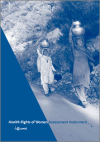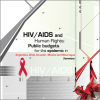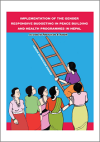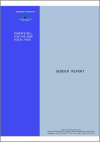FOUND 27 RESULTS
The Health Rights of Women Assessment Instrument (HeRWAI) is a tool developed by the Humanist Committee on Human Rights (HOM) in 2006 to enhance lobbying activities for better implementation of women's health rights. A HeRWAI analysis links what actually happens with what should happen according to the human rights obligations of a country.
This study of HIV/AIDS, human rights and budgets in five Latin American countries (Argentina, Chile, Ecuador, Mexico and Nicaragua) was prepared by Fundar Centro de An¡lisis e Investigaci, October 2004. The study is part of an international initiative, coordinated by the AIDS Budget Unit of Idasa in South Africa and generously supported by SIDA (Swedish International Development Cooperation Agency). The regional coordination for Latin America was undertaken by Fundar. The report aims to...
This synthesis paper examines the evolution of efforts to address domestic violence in Latin America. In the outset, the authors elucidate the methodological dilemmas involved in collecting data on domestic violence. The paper discusses some of the outcom
This synthesis paper examines the evolution of efforts to address domestic violence in Latin America. In the outset, the authors elucidate the methodological dilemmas involved in collecting data on domestic violence. The paper discusses some of the outcomes of domestic violence laws, including government actions undertaken, strategies used to implement laws when funding is lacking, and the extent of domestic violence services resulting from domestic violence laws. The paper also provides a...
This synthesis paper examines the evolution of efforts to address domestic violence in Latin America. In the outset, the authors elucidate the methodological dilemmas involved in collecting data on domestic violence. The paper discusses some of the outcom
This publication is a compilation of two studies carried out to assess GRB in the peacebuilding and Health programmes under the EC/UN Women...
The Global Programme ‘Increasing Accountability in Financing for Gender Equality’ was developed to increase financing for national gender equality commit¬ments in sixteen countries and to strengthen government and donor accountability on financing decisions and practices. Drawing on diverse country experiences, this brief showcases the programme’s comprehensive ap¬proach together with its achievements and lessons. It also provides policymakers and gender advocates with...
The objective of this report is to review and analyze the impact of the major sectoral programmes to identify some areas of intervention to better take into consideration the gender dimension in the design of public policies.Six new government departments which have adopted gender-sensitive budgeting are covered by the 2008 Gender Report, bringing their total number to 17 departments. The report is also market by the introduction of a gender analysis of goal indicators.
This easy-to-read publication seeks to contribute to the reflection process on an approach and a set of instruments that are geared towards the evolution in development thinking and practice. The note first argues why a gender dimension is best integrated into the evolving aid modalities. The extent to which PRSPs and SWAPs in practice take into account lessons learned is examined. Finally, the note discusses a number of avenues for making the new forms of aid more gender-sensitive, taking into...
This report focuses on the responses of international aid agencies working on violence against women (VAW) in Central America and, in particular, the situation in Honduras. One of the conclusions of the publication is that International organisations should commit to gender budgeting, which is important as an indicator and create mechanisms to monitor their own organisations performance on VAW.





